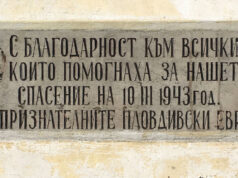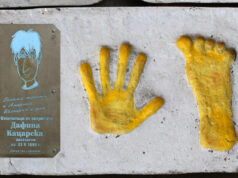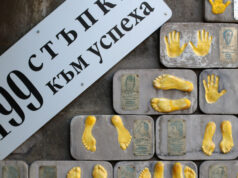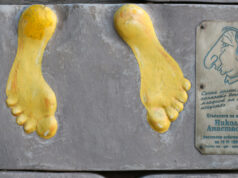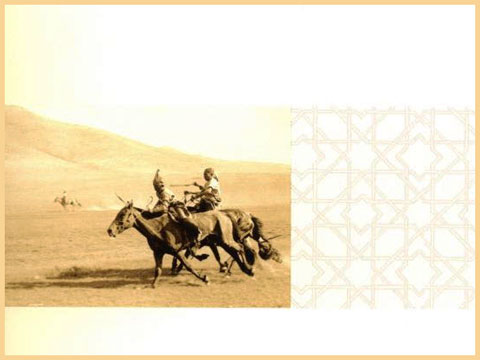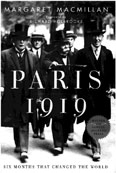 Review of Margaret MacMillan’s Paris 1919: Six Months That Changed the World.
Review of Margaret MacMillan’s Paris 1919: Six Months That Changed the World.
…with a special focus on the part about Bulgaria, and especially on Alexander Stamboliski’s hand.
By David McAuley
When reviewing a book, it is generally considered good form to review the whole book, not just one chapter or even one page. So, before my descent into bad reviewing form, I’d like to say that this is a fine book about the Versailles Peace Conference, written by a grand-daughter of British Prime Minister David Lloyd George. When she tells you that French Prime Minister George Clemenceau during the conference once attempted to interest a young, newly-married daughter of DLG in a bunch of dirty postcards, you can be pretty sure she got it from a reliable source.
Basic Instructions to the Reader
Most continental European countries receive attention in separate chapters. If you were limited in time and money and wish to do a cheap and simple brush-up on this bit of history in preparation for a visit to Bulgaria, I’d recommend the following:
- Read the Wikipedia entry on the Treaty of Versailles
- March into your bookstore or library
- Find a copy of Paris 1919
- Open to Chapter 11
- Read about Bulgaria’s part in the Treaty
However, it would clearly be better to read the book from cover to cover.
The Hand of Stamboliski
Interested as I am in things Bulgarian, I read Chapter 11 with special attention, especially the following about then-Prime Minister Alexander Stamboliski:
In June 1923, there was a coup; Stamboliski was killed by Macedonian conspirators who first cut off the hand which had signed the anti-terrorist agreement with Yugoslavia.
Desperate as usual for material in my next Bulgarian conversation class, I mentioned this event (only average gruesome by Balkan standards) to my teacher. Not true, she said, the writer must be thinking of Stefan Stambolov (died 1895), a man who shared the following qualities with Stamboliski: was Bulgarian, was Prime Minister a long time ago, died violently for political reasons, was killed by Macedonians, had the same initial seven letters in his surname.
I decided to investigate whether MacMillan made a factual error about the hand in the above sentence. (Spoiler: Probably not.)
Source Checking the Hand of Stamboliski Question
The footnote associated with the paragraph directed me to Crown of Thorns: The Reign of King Boris III of Bulgaria 1918-1943 by Stephane Groueff and A Concise History of Bulgaria by R. J. Crampton. Groueff mentions the allegation about the hand, and other allegations of torture, but then says:
So many political groups wanted to use Stambolisky’s [sic] assassination to accuse other factions or to justify future revenge that the complete truth has been obscured. But no matter the differences in the cruel details, the fact remains that Stambolisky was killed in the most abominable way.
Well observed, but inconclusive about the hand. I proceeded to Crampton, pgs. 96 – 98, as mentioned in the footnote. I found that these pages refer to the life and death of Stefan Stambolov. Aha! I thought. Gotcha! Then my long-suffering wife, whose dust I eat in the area of being a Balkan history geek, recalled a photograph from the book Foxy Ferdinand: Tsar of Bulgaria by Stephen Constant, in which Stambolov is lying in his coffin, with his severed hands in a glass jar beside it. Double gotcha!
Rather than rushing to publish a libelous screed accusing MacMillan of shoddy research, I felt the need to look into this further. (This is an example of why my career as a journalist went nowhere.) My next stop was History of the Balkans: Twentieth Century by Barbara Jelavich, generally considered to be the gold standard of English-language histories of the region, and also cited by MacMillan as a source elsewhere.
This turns out to be the source of the story about Stamboliski’s hand. MacMillan can only be accused of erroneous footnoting.
Digging Deeper into the Mystery
Jelavich says that Stamboliski:
was captured by a [Macedonian] band and tortured. His right hand, which signed the Treaty of Nis, was cut off, and he was stabbed sixty times.
What was Jelavich’s source? The book has no footnotes, only a bibliography, which includes many obscure old histories which even hard-core Balkan history geeks do not have on hand. So, the trail grows cold. Given the esteem in which the Jelavich book is generally held, I’m willing to take her word for it.
(Also, the fact that two separate Bulgarian Prime Ministers, within the space of 30 years, had their hands cut off before they were killed doesn’t strike me as in the least bit odd or revolting, which probably means I’ve been in the Balkans too long.)
However, the case is far from closed. Hugh Seton-Watson, in Eastern Europe Between the Wars 1918 – 1941 says that Stamboliski:
…was then taken by some Macedonian terrorists, who led him back to his home, where they mutilated and tortured him, made him dig his own grave and finally finished him off.
Assuming that Seton-Watson meant to convey that the final grisly activities took place one after another in the order he described, this would tend to indicate that Stamboliski did not have his hand cut off before dying. Even Macedonian terrorists are not short-sighted enough to cut off a man’s hand first and demand he dig his own grave second.
Conclusion
In summary, the tale of Stamboliski’s hand is a colorful story, illustrative of the cruel and violent nature of Balkan politics. There was enough evidence for a responsible historian to guess that it might be true, so it went into the narrative. If anecdotes are repeated often enough in this way, they become history.
Order Paris 1919: Six Months That Changed the World right now from Amazon.com.
Contents:
Foreword
Acknowledgments
Note on Place-names
Introduction
Part 1 Getting Ready for Peace
1 Woodrow Wilson Comes to Europe
2 First Impressions
3 Paris
4 Lloyd George and the British Empire Delegation
Part 2 A New World Order
5 We Are the League of the People
6 Russia
7 The League of Nations
8 Mandates
Part 3 The Balkans Again
9 Yugoslavia
10 Romania
11 Bulgaria
12 Midwinter Break
Part 4 The German Issue
13 Punishment and Prevention
14 Keeping Germany Down
15 Footing the Bill
16 Deadlock Over the German Terms
Part 5 Between East and West
17 Poland Reborn
18 Czechs and Slovaks
19 Austria
20 Hungary
Part 6 A Troubled Spring
21 The Council of Four
22 Italy Leaves
23 Japan and Racial Equality
24 A Dagger Pointed at the Heart of China
Part 7 Setting the Middle East Alight
25 The Greatest Greek Statesman Since Pericles
26 The End of the Ottomans
27 Arab Independence
28 Palestine
29 Ataturk and the Breaking of Sevres
Part 8 Finishing Up
30 The Hall of Mirrors
Conclusion
Appendix Woodrow Wilson’s Fourteen Points
Bibliography
Notes
Index
Citation:
MacMillan, Margaret. Paris 1919: Six Months that Changed the World, New York: Random House, 2001.
[ad#Amazon Books bulgarian history, bulgaria]



